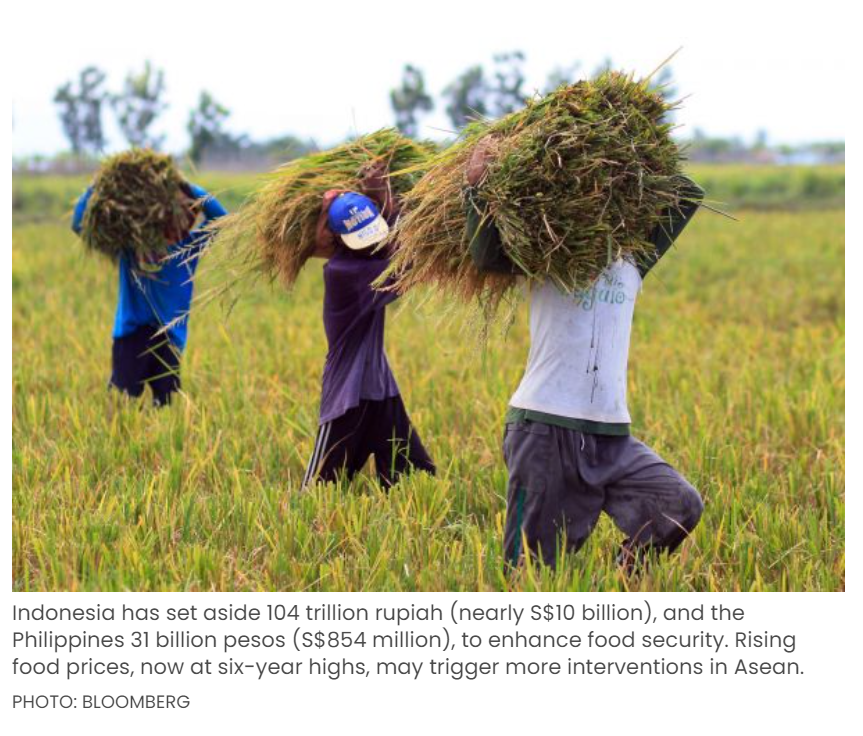Rising food prices a boon for rural incomes, may trigger food security interventions in Asean: Maybank KE
AGRICULTURAL prices have led a remarkable rally in commodity prices since the third quarter of 2020. Food inflation could lift rural incomes and employment, while triggering Asean governments to increase production and implement more food subsidies, said a Maybank Kim Eng (Maybank KE) report on Friday.
The increases are visible in key commodities for Asean such as palm oil, rubber, rice and coconut oil, noted the report. And as at December 2020, the United Nations Food and Agriculture Organization’s Food Price Index is at its highest level in six years.
The index averaged 107.5 points in December, marking the seventh month of consecutive increase. Food prices have now jumped 18 per cent since their trough in May, boosted by factors including adverse weather, supply chain and labour disruptions, and stockpiling due to lockdowns.
Many Asean countries are major commodity exporters and will benefit from rising prices, noted the report. Net commodity exports represent a significant share of gross domestic product (GDP) for countries like Vietnam (4.3 per cent), Indonesia (3 per cent), Laos (2.5 per cent), Myanmar (2.4 per cent) and Malaysia (1.7 per cent).
In particular – with about 30 per cent of Asean’s total employment in agriculture – rising food prices can have a “powerful redistributive impact” by raising rural incomes and employment, said the report. This could help offset the disproportionately large impact of the pandemic on lower income households.
In Thailand, for example, rising export prices of rice and rubber has led to farm income rising by 14 per cent in November 2020. In Indonesia, the agriculture sector posted the largest increase in employment (+7.8 per cent) in August 2020 from a year ago, while most other sectors saw declines (the largest being -8.9 per cent in manufacturing).
The impact on overall inflation is also expected to be small. Though food price increases are outpacing overall consumer price index inflation in Asean, they are being offset by factors including sluggish domestic recovery, subdued wage pressures, a weak US dollar and existing food subsidies, said the report.
Looking ahead, however, foreign labour shortages present upside risks to food inflation. In particular, Thailand’s seafood industry is highly dependent on migrant workers – who are now at the epicentre of a new Covid-19 wave, following last month’s outbreak in a Samut Sakhon seafood market. Similarly, Malaysia’s palm oil industry is facing a labour crunch due to border controls and migrant worker outbreaks.
Amid Covid-19, Asean governments have stepped up their food security policies and subsidies. Maybank KE anticipates they may do so further if price surges continue or food shortages emerge.
Last April, Indonesia expanded the coverage of its staple food card programme from 15.2 million to 20 million recipients. Since October, Thailand has implemented a co-payment scheme that subsidises 50 per cent of food, drink and general purchases at small shops. In December, the scheme was extended until March 2021, and expanded to cover an additional five million citizens from 10 million previously.
Governments are also beefing up domestic production to enhance food security. The Philippines has allocated 31 billion pesos (S$854 million) under its “Plant, Plant, Plant” programme to ensure food sufficiency amid the pandemic. Of this, 8.5 billion pesos will go towards increasing domestic rice production from 87 per cent to 93 per cent of rice consumption.
Meanwhile, Indonesia has earmarked 104 trillion rupiah (nearly S$10 billion) for food security, including strengthening food infrastructure and technology. Singapore, dependent on food imports, aims to ramp up domestic food production to 30 per cent by 2030 (“30 by 30”), up from just 10 per cent currently. Agriculture contributes only 0.03 per cent of GDP and under 0.7 per cent of employment in the city-state.
Source: https://www.businesstimes.com.sg/asean-business/rising-food-prices-a-boon-for-rural-incomes-may-trigger-food-security-interventions


 Thailand
Thailand




